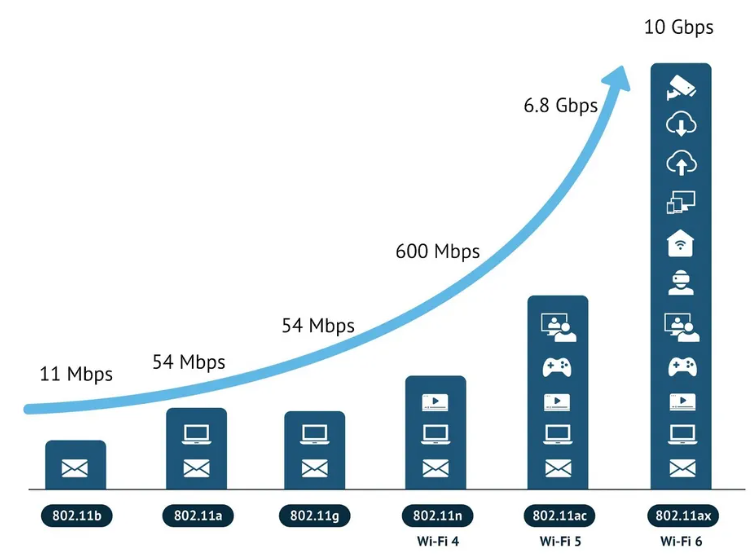Welcome: Shenzhen Limei Technology Co., Ltd
Email: szlimei@tddfdd.com
- TOP
- 13025463935
- Online
- WhatsApp code


802.11b
Wi-Fi 802.11b, often referred to simply as "Wi-Fi 1," was the first widely adopted wireless networking standard. It operates in the 2.4 GHz frequency band, which is also used by many other wireless devices like cordless phones and microwaves. It supported a maximum theoretical rate of 11 Mbps and had a range up to 150 feet.
802.11b components were inexpensive, but the standard had the slowest maximum speed of all the 802.11 standards. And since 802.11b operated in the 2.4 GHz, home appliances or other 2.4 GHz Wi-Fi networks could cause interference. Today, routers that only support 802.11n are no longer manufactured.
802.11a
Wi-Fi 802.11a is a wireless networking standard introduced in 1999 as part of the 802.11 family of Wi-Fi standards. It operates in the 5 GHz frequency band and offers faster data rates compared to its predecessor.
Why did 802.11b come before 802.11a?
The ‘a’ amendment to the standard was released at the same time as 802.11b. But it introduced a more complex technique, known as OFDM (orthogonal frequency division multiplexing) for generating the wireless signal.
In other words, 802.11a offered a few advantages over 802.11b:
You probably haven’t encountered many 802.11a devices or routers. This is because 802.11b devices were cheaper and became more popular in the consumer market. 802.11a was mainly used in business applications.
802.11g
The 802.11g standard used the same OFDM technology introduced with 802.11a. Like 802.11a, it supported a maximum theoretical rate of 54 Mbps. But like 802.11b, it operated in the crowded 2.4 GHz frequency (and thus was subject to the same interference issues as 802.11b).
802.11g was backward compatible with 802.11b devices: an 802.11b device could connect to an 802.11g access point (but at 802.11b speeds).
With 802.11g, consumers enjoyed a significant advance in Wi-Fi speeds and coverage. At the same time, consumer wireless routers were getting better, with higher power and better coverage than earlier generations.
802.11n (Wi-Fi 4)
With the 802.11n standard, Wi-Fi became even faster and more reliable. It supported a maximum theoretical transfer rate of 300 Mbps (and could reach up to 450 Mbps when using three antennae).
802.11n used MIMO (Multiple Input Multiple Output) where multiple transmitters/receivers could operate simultaneously at one or both ends of the link to a single device. This provided a significant increase in data without needing a higher bandwidth or transmit power.
802.11n operated in both the 2.4 GHz and 5 GHz bands
802.11ac (Wi-Fi 5)
802.11ac supercharged Wi-Fi, with speeds ranging from 433 Mbps all the way up to several Gigabits per second. To achieve this kind of performance, 802.11ac:
With beamforming, the antennae basically transmit the radio signals, so they’re directed at a specific device.
Another significant advancement with 802.11ac was multi-user MIMO (MU-MIMO). While MIMO directs multiple streams to a single client, MU-MIMO can direct the spatial streams to multiple devices simultaneously.
While MU-MIMO doesn’t increase the speed to any single client, it can increase the overall data throughput of the entire network.
Wi-Fi 5 was a big step for Wi-Fi evolution. Now, Wi-Fi is taking another big leap from 5 to 6.
Wi-Fi 6 (802.11ax)
The newest generation Wi-Fi standard is Wi-Fi 6. We were used to Wi-Fi 5 being supercharged with changes, and now Wi-Fi 6 offers even more.
The biggest things to know about the newest standard is that Wi-Fi 6:
Unlike past standards, Wi-Fi 6 allows one router to handle more antennas. Which means one router can connect to more devices.
Wi-Fi 6 is designed to make wireless internet better in homes and in public.
Wi-Fi 6E
You might see Wi-Fi 6E on some devices. The thing you need to know about Wi-Fi 6E is that it is the same as Wi-Fi 6 except for one thing: the frequency band that it can extend to. Wi-Fi 6E supports an all-new 6GHz frequency, which has higher throughputs and lower latency.
Contact: Sorho
Phone: +8613025463935
Email: szlimei@tddfdd.com
Add: 1006, 10th Floor, Shajing Yunhua Times Building, Shenzhen, Guangdong, China